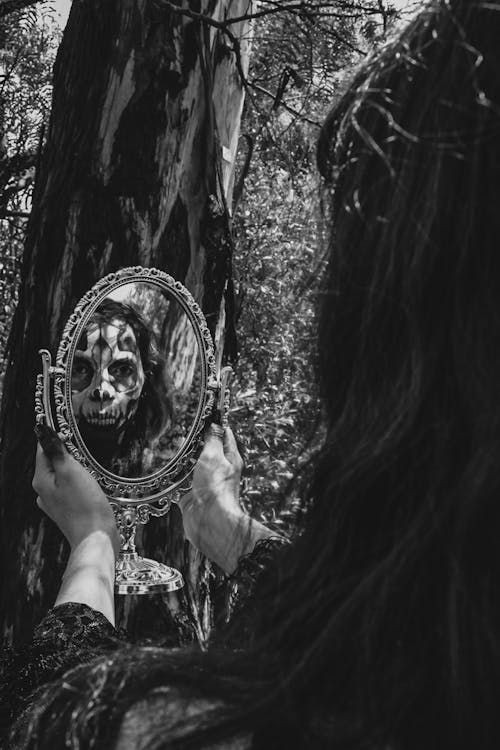chocolates-and-daisies
163 posts
lena or lennie | she/they | 19
Don't wanna be here? Send us removal request.
Text
I used my Happy Apple™️ for sound cleansing a few weeks ago. For it is the most magical sound I know.
144 notes
·
View notes
Text
Mirror Magick Applications

Mirrors are a big part of our lives. Mirrored surfaces, both man-made and natural exist almost everywhere. Every culture has myths regarding mirrors and I'm sure some of these we have all heard. Such as breaking a mirror is worth seven years of bad luck, that you shouldn't keep them in the bedroom, or to cover all your mirrors after someone dies, so their soul isn't trapped. Mirrors are more than just shiny bathroom fixtures, they are literal portals and amplifiers with several magickal utilities.
Trapping Energy by Charging Mirrors
Mirrors can be used to 'trap' the energy of any setting you find particularly powerful. For example: leaving your mirror close to the ocean waves or in a dark forest overnight. It will absorb the potent natural energies, then you can use the mirror in late workings as you please.
Lunar magick is another area where mirror work is ideal. Place a few mirrors under the moon to charge them with the energy of that phase. If you want to use them for a specific purpose, consider marking them with a symbol or sigil. When you need the energy of the moon, or a moon phase, you can access it as needed by using an appropriately charged mirror.
Amplification
Mirrors, like crystals, can help to amplify the power of your spells ans rituals. Keeping a mirror on your altar can bolster and increase the success of your workings. Just as focused sunlight on a mirror ignites a fire, focused magick will ignite a spell. Make sure your spell components are reflected, or better yet, perform the working on top of a mirror, to substantially increase its power.

Scrying and Accessing Other Realms
When correctly utilized mirrors can be used to access messages and visions that we wouldn't normally be able to connect with. Scrying is an ancient divinatory magick that is often used as a form of fortune-telling. Traditionally, a lot of scrying was done with water, the ancient Celts and Greeks even practiced this form of divination. Mirror scrying is an evolution of these water oracles, with historical practitioners like the famous John Dee, who used highly polished silver, brass, mercury, or obsidian.
Scrying wit mirrors can be particularly powerful due to the idea that your reflection is the manifestation of your soul. When viewing your reflection, if you're well in tune with yourself, you can ask your soul questions regarding your life and development or even open up the door to another dimension entirely. Mirrors can be enchanted and sigified into being gateways in and of themselves.
Many scrying mirrors are black because one's own reflection can be rather distracting. The traditional material of a black mirror is obsidian, however you can craft your own by painting one side of a piece of glass black. Picture frames are great for this. A black mirror is the best option for scrying as you won't be distracted by your own features, leaving you open to interpret your visions.

Banishing
Mirrors, as reflective surfaces and magickal conductors, are often used in banishing spells. Banishing magick can be used when someone is directing negative energy your way or you're being harassed. In this case, a mirror can be used to return bad energy back to the person who sent it.
Banishing magick can be a wonderful tool when applied to bad habits or negative thoughts as well. To banish an idea or behavior, encant something akin to: "[what you're banishing] you've caused me pain, I banish you, now stay away. Mirror help to reflect my plight, and keep [what you're banishing] out of sight". Keep the mirror close to you in order to protect you from what you're banishing.
Defense
Mirrors are also an incredibly effective defensive tool. They can deflect any negative energy, ill intent, or malevolent spirits sent your way. By placing mirrors in areas where you need the most protection, you can repel any unwanted energy trying to infiltrate your space. For added potentcy, draw a protective sigil/symbol on the mirror and/or place a protective crystal in front of it.

Hexenspiegal: The Witch's Mirror
A hexenspiegal is a small mirror used as a protective charm to reflect away baneful/attack magick, the evil eye, and other bad omens and intentions, as well as return the energy back to its sender. Its basis is in German folk magick. Translated, it means "witch's mirror". Hexenspiegals may be suspended from cords, fastened to walls, or, in the case of small ones, worn as jewelry. You can make your own by cleansing, decorating (optional), and sigifying/enchanting a small mirror to your intent.
278 notes
·
View notes
Text
Currently reading "Skull Scrying: Animal Skulls in Divinatory Trance Work" by Lupa Greenwolf and I'm genuinely enjoying it? Like, yeah, sure, I don't think I like the usage of the word "totem" in this context when it pops up, but that's literally the only irk point? Other than that, I've really liked it and liked Lupa's approach? She emphasizes things like legally and ethically obtaining animal skulls, asking the spirits for permission each time to scry with them, stuff like that. I get the feeling that I'll be picking up more of her works soon...
22 notes
·
View notes
Text
Currently reading "Skull Scrying: Animal Skulls in Divinatory Trance Work" by Lupa Greenwolf and I'm genuinely enjoying it? Like, yeah, sure, I don't think I like the usage of the word "totem" in this context when it pops up, but that's literally the only irk point? Other than that, I've really liked it and liked Lupa's approach? She emphasizes things like legally and ethically obtaining animal skulls, asking the spirits for permission each time to scry with them, stuff like that. I get the feeling that I'll be picking up more of her works soon...
22 notes
·
View notes
Text
stop romanticizing bad decisions
4 notes
·
View notes
Text









Bear Selfies Captured By Camera Traps
76K notes
·
View notes
Text
𓋼𓍊𓋼𓍊Wild Plant Lore P.2 𓍊𓋼𓍊𓋼
Some more notes from my herbology journal of wild plants and weeds that you can utilize in your practice. Includes mundane uses like culinary, medicinal properties, folklore/cultural importance, and magical associations. This post does contain poisonous/toxic plants that can be fatal if ingested, I'm not suggesting anyone inexperienced or experienced do anything with them, do your own research on how to handle them if you plan on using them in any way. They're interesting to learn about nevertheless.
Disclaimer at the end !!
𓍊𓋼𓍊𓋼𓍊𓋼𓍊𓋼𓍊𓋼𓍊𓋼𓍊𓋼𓍊𓋼𓍊𓋼𓍊𓋼𓍊𓋼𓍊𓋼𓍊𓋼𓍊𓋼𓍊𓋼𓍊𓋼𓍊𓋼𓍊𓋼𓍊𓋼𓍊𓋼
Yarrow- Also known as common yarrow, bloodwort, herba militaris, or Achillea Millefolium. Yarrow is a woody plant with small, round, white flowers and frilly, feather-like leaves surrounding the stems. This plant looks very similar to hemlock which is very poisonous but you can tell the difference by yarrow’s distinctive leaves. Yarrow is edible and can be eaten raw, it tastes pretty bitty and earthy so it’s best to pick while young. It’s most commonly used in salads and soups. Yarrow has a rich medicinal and magical history. It used to be called herba militaris, the military herb, because of its astringent properties. Its Latin name, Achillea Millefolium, comes from the Iliad where Achilles and his soldiers use yarrow during battle. Poultices and ointments made from its leaves are used to aid in lessening swelling and bleeding. Do not consume yarrow if you are on blood thinners or pregnant/lactating, this plant has a chance of causing miscarriages. People are commonly allergic to this plant so please be wary of this and test it before consuming, skin allergic reactions are the most common. Yarrow is also commonly used to treat stomach ailments like constipation, nausea, diarrhea, and IBS symptoms. The plant contains flavonoids that increase saliva and stomach acid to help improve digestion. It's also been used for menstrual pains and stomach aches as it can help relax the uterus and intestinal muscles. Some Native American nations have used yarrow for toothaches, earaches, and eyewashes through poultices and liquid infusions. There's no end to the magic of yarrow, there are so many different charms, divinatory practices, and spells that use yarrow in cultures worldwide. Many cultures have used it to keep away curses and evil magic, they would place it on their doorsteps to ward off evil spirits and keep witches away, or in cribs to protect babies and mothers. “When going on a journey, pull ten stalks of yarrow, keep nine, and throw the tenth away (as a spirit’s tithe), put the nine under the right heel, and evil spirits will have no power over you”.
It’s often been used in divination and psychic senses. In Ireland, it’s thought to be able to give someone ‘the second sense’ and it’s used in a lot of divinatory prayers and charms, usually to do with finding love. It’s also sometimes said that standing on the plant would give one temporary fluency of speech. There is a ceremony of some Gaelic speakers where they had to recite an incantation (the one below this block of text) before harvesting the plant as it was held to high importance. In Chinese belief, it’s thought to bring good luck and the dried stalks are sometimes used in I Ching divination.
“I will pluck the yarrow fair That more benign will be my face, That more warm shall be my lips, That more chaste shall be my speech, Be my speech the beams of the sun, Be my lips the sap of the strawberry. May I be an isle in the sea, May I be a hill on the shore, May I be a star in the waning of the moon, May I be a staff to the weak. Wound can I every man, Wound can no man me.”
It’s widely used in love divination, sometimes people would put it under their pillows at night and say the rhyme below before bed. Sometimes they would pick yarrow from a young man's grave and whoever the girl saw in her dream would be hers. In some beliefs, if the man was turned to her then they’d never marry.
“Yarrow, yarrow, yarrow, I bid thee good morrow, And tell me before tomorrow, Who my true love shall be.”
Girls in Aberdeen would go out in fields on a May morning to pick yarrow while reciting the chant below with their eyes closed, then open their eyes and the first man she spied would be hers that year. There are a lot of little incantations and charms like this for yarrow you can find online if you’re curious !!
“Good morrow, good morrow, To thee, braw yarrow, And thrice good morrow to thee; I pray thee tell me today or tomorrow Who is my true love to be.”
Alternatively, in some European beliefs, it was thought to be associated with the devil, being called devil’s nettle or “bad man’s plaything” due to the belief that witches used it in divination and devil worship. Elspeth Reoch was accused of being a witch in 1616 because she was caught picking supposed yarrow. In Wales, it was considered extremely unlucky to bring into the home and even supposedly called the “death flower” in some places.
⛧ Divination, love, protection from curses, witchcraft, and spirits. But also bad luck, curses, and death in some cultures
Datura- Also called devil’s trumpets, jimsonweed, and devil’s snare. Datura is a genus of 9 species, all of which are poisonous. Datura is a large, branchy herb that forms bushes. It has light green or reddish stems with long, toothed leaves and white or light violet, trumpet-shaped flowers. While the plant may look pretty but it’s very toxic and can be deadly. All parts of the plant are inedible and if ingested it causes a hefty amount of psychoactive and deliriant symptoms like erratic behaviour, hallucinations, tachycardia, heat flashes/hyperthermia, and a variety of other not-so-pleasant symptoms including death. While this plant is psychoactive it’s not a good idea to try to use it recreationally as the symptoms can last up to two days with reports of it lasting for as long as 2 weeks. There have been multiple reports of deaths from people attempting to get a high out of datura and even when “successful” the majority of people report having extremely unpleasant experiences. Datura is also often called Jimsonweed which comes from another name, Jamestown weed, which refers to when English soldiers were attempting to suppress Bacon’s rebellion in Jamestown and consumed boiled datura which left them in altered mental states and ill for 11 days. Because of how dangerous this plant is, there aren’t any real suggested medicinal uses for it. Datura has been used in many cultures for ritual and ceremonial practices due to its psychoactive effects. Many Native American nations used it in very specific ways to aid in their ceremonial practices alongside other sacred herbs. The name datura is taken from the Hindi word धतूरा, dhatūra, meaning thorn apple (in reference to Datura metel, a datura species native to Asia). Datura plays a role in Hinduism as datura is considered a favourite plant of Shiva. Datura also has a long history in witchcraft and the occult, it’s long been associated with witches and magic due to its psychoactive effects. Throughout many cultures, its been used to help connect with deities and spirits, aid in necromancy, healing rituals, and used in flying ointments and curses. In modern-day practice, datura is still fairly commonly used to promote psychic powers and aid in visions, astral projection, divination, and spirit communication. Additionally, likely due to its history of being used as a poison, it’s often used in curses.
⛧ Psychic senses, spirit communication, astral projection, curses
Lily of The Valley- Also known as glovewort, May bells, Our Lady’s Tears, and Convallaria majalis. Lily of the Valley is a flowering plant made up of one thin stalk that has two thick, long, swirling leaves. The downturned white, bell-shaped flowers droop to one side and are often accompanied by small red berries. These plants are often found in woodland areas and bloom in the Spring. Lily of the Valley is not edible and if ingested can be fatal. The entire plant is poisonous and can cause irregular heartbeats, nausea, vomiting, and abdominal pain if consumed. If touched, it can cause dermatitis and skin reactions so always wash your hands after handling it or use gloves. Despite that, the plant has been used in a lot of folk medicines. It’s often called glovewort in Europe as it was used in salves for sore hands and oils from the rhizome were used to promote heart health. There have been no studies done to verify its effectiveness and it’s often unsafe to consume and touch so it’s not recommended to try to use it medicinally. Although it’s poisonous, it has a very strong and sweet-smelling fragrance that many perfumes have recreated. Lilies of the Valley are often seen at weddings, celebrations, and sometimes funerals. In the Language of Flowers, Lily of the Valley signifies the return of happiness, likely originating from its place as the flower of Spring and May. On May 1st, May Day or Lily of the Valley Day is celebrated by giving the flowers to loved ones to bring happiness and luck. It’s sometimes called Apollinaris from the Greek myth that Apollo made paths of it on Mount Parnassus so his 9 nymph muses could walk through the forests unharmed. In Christianity, it’s sometimes referred to as Our Lady’s Tears or Mary’s Tears from the story saying that as Mary wept at the foot of the cross after Jesus’s crucifixion, these flowers popped up wherever her tears fell. Because of this, it’s often associated with Easter and motherhood. In Romanian culture, it also represents tears with a similar story of a girl crying at the grave of her parents and her tears causing the flowers to sprout wherever the tears fell. Unfortunately, I couldn’t find much about this story beyond a brief mention though. Because of the bell shape of the flowers, there are stories of faeries ringing the bells, drinking out of them like cups, and being attracted to gardens where they grow. Lily of the Valley can be used to promote happiness, help calm the mind, and attract fae. Additionally, the poisonous berries and flowers are sometimes used in baneful and protective spellwork to stop harassment (calm chaos/harm) and protect against spells and malicious entities.
⛧ Happiness, love, motherhood, purity/humility, Spring, prosperity, faeries. Grief, death, and baneful protection in some beliefs
Mugwort- Also known as common mugwort, mother of all herbs, the witch’s herb, and Artemisia vulgaris. This is a very common flowering plant that’s a part of the daisy family. Mugwort can oftentimes be found in the wild, it has leaves that are hairless and green on top, silvery-white on the bottom, with pointed tips and purple stems. Mugwort can often be mistaken for Ragweed or Wormwood but the best way to tell them apart is that Mugwort has leaves that are hairless on top with silvery fibers on the bottom. It’s very aromatic and smells a bit like sage and rosemary. Mugwort’s leaves, young shoots, and roots are edible, though avoid consuming it in large amounts as it can be poisonous and it’s not safe to consume if you are pregnant (can restart the menstrual cycle and cause miscarriage) or on blood thinners so please talk to a doctor before using. It has a slightly bitter and floral taste, the young shoots and leaves can be cooked, and the leaves and roots can be dried and made into tea. Commonly used with meats, soups, or teas. Historically, this plant has been used for centuries for its medicinal properties with many uses to soothe stomach and digestion issues like constipation, diarrhea, nausea, and cramping. It was held so important that it was given the name mother of herbs. Huge warning for this plant though, there is a high chance that you could be allergic to it or for it to cause negative side effects like allergic reactions, nausea, shaking, hallucinations, dizziness, and seizures. This is a plant that you need to take caution around and do your own research for, as beneficial as it can be, it can be just as harmful. Avoid heavily concentrated oils of mugwort too as they may include high levels of thujone which can cause seizures, the raw plant contains little enough for this to be considered a safe plant to generally consume, this can also be absorbed through the skin. In many cultures, the plant is smoked or drank in teas. Essential oils of mugwort have also been used in insect repellents and traditionally root tinctures have been used for anxiety, irregular menstrual cycles, menopause symptoms, aid in childbirth, seizures, and epilepsy.
Mugwort is a pretty prominent plant in many cultures around the world and is very commonly used in magic. Its botanical Latin name is Artemisia Vulgaris, Artemisia comes from the goddess Artemis who is a god associated with the moon, motherhood, and childbirth which ties into the lore of mugwort. Mugwort teas are often used to promote lucid dreaming, astral projection, and heightened intuition. It’s commonly used in flying ointments, psychic teas, and incense. Mugwort also offers some protection against evil and illness, St. John the Baptist was said to carry springs with him to ward off evil and before that. In many European cultures there are Midsummer rituals where it was thrown into fires to offer protection to ward off witches, evil spirits, and illness. In a lot of cultures, mugwort is used to open the doors between the spirit realm and ours, many people use it for prophetic dreams or to connect with ancestors. Sprigs of mugwort were placed over doorways to keep away evil spirits and illness and satchels of the herb are commonly placed near beds or under pillows to induce lucid dreaming, prophetic dreams, and astral projection. In modern practice, it’s very commonly used to promote lucid dreams and astral projection by drinking it in teas or lighting incense. As well as used to aid in divination and spirit communication. Truly the witch’s herb :)
⛧ Lucid dreaming, astral work, clairsenses/psychic work, lunar associated, motherhood/womanhood, divination, ancestor/spirit work, protection from bad health, evil spirits, and nightmares
Purslane- also called pigweed, hogweed, and Portulaca oleracea. Purslane resembles a jade plant with a thick, succulent red stem and smooth succulent leaves. It’s a very low-growing plant that tends to spread outward from its center. Purslane’s leaves, stems, and flowers are edible. It tastes tart and slightly salty, similar to spinach or watercress. You shouldn’t consume it if you are prone to kidney or urinary tract stones as it contains oxalic acid. Purslane is often used in salads, soups, smoothies, and commonly even omelets. It’s considered to be a superfood but that’s generally an arbitrary term, it is a very nutritious plant nevertheless as it contains a lot of antioxidants and Omega 3 acids. Purslane is used medicinally on small wounds and burns to aid in wound health. It’s used in skincare for its anti-inflammatory properties and to reduce the visibility of wrinkles and scars. Purslane may have a cooling effect so people have used it for fevers. There are a lot of different medical uses attributed to purslane but not much scientific proof validating the claims so I won’t really go into those very much but it was often used to cure toothaches and soothe the kidneys and liver, some would call it a cure-all plant. Some will use it to help with their diabetes as it may help reduce blood pressure. Purslane was used widely as a medicinal herb and was thought to drive away illness if worn. It was considered a protective herb in many cultures, many would place it around their homes, beds, and under pillows to ward against illness, evil spirits, and magic. When researching purslane I found a lot of mentions of an old German herbal book from 1715 by Axtelmeier that said
“Even though purslane is cold and moist, it is a real summer plant and does not like the cold. There is a saying that in marriage it is always good when two different temperaments join together. The good Lord alone knows what is best and for that reason sometimes two very different personalities join together in marriage”.
I couldn’t find for the life of me the actual work it was from but there are many mentions of this passage online. There are also some references to people having worn purslane to protect themselves from gunshots, lightning, and illness. Purslane is also said to help aid in clairvoyance, scrying, and astral projection, perhaps because of its association with the moon.
⛧ Harmony, marriage, clairvoyance, astral projection, protection from spirits, illness, and harm
St. John’s Wort- Also known as perforate St. John’s wort (SJW) and Hypericum perforatum, not to be confused with mugwort. A woody flowering shrub with bright yellow, five-petalled leaves, each with a small black dot on the edge that can be seen when held up to light. It has dark green leaves which also often have those same small black, although sometimes transparent, dots. While SJW is not really regarded as being poisonous, it’s not ingestible so it’s not recommended to eat it. It’s not technically edible or not edible, the flowers and fruit are used medicinally but that’s usually the extent of consumption. If you do eat it, you may experience an upset stomach, headaches, confusion, trouble sleeping, fatigue, dizziness, sensitivity to sunlight, and increased anxiety. There aren’t many culinary uses for it, most of this will be about its medicinal uses. SJW has been used medicinally for a very, very long time, both in historical and modern-day use. This plant is usually consumed through teas, liquid extracts, and (more recently) pills made from the flowers. It’s said to taste slightly bitter but similar to black tea though is often times paired with other herbs. Historically, the Greeks used to use it to aid in wound healing, treat anxiety and aid in sleep. Some Native American nations also used it for wound healing, it has some antibacterial, antiviral, and anti-inflammatory properties which make it good to treat minor burns, abrasions, and bruises, this is usually done through the use of an infused oil. In Europe, it was also used to treat minor wounds and burns along with lung and kidney ailments and to treat anxiety and depression. SJW has been used to help with anxiety and depression in many different cultures and more recently there have been studies done to prove that it can help, in fact, it’s been shown to be as effective as some common antidepressants for mild and severe depression. It’s also still commonly used as a sleep aid. Do not take SJW if you’re on medications treating HIV/AIDS, or pregnant as it can very likely cause a miscarriage.
In Europe, where it originates, it was used often for its protective properties — people would hang it over their doorways to ward off demons, faeries, evil spirits, and even storms. Some would wear SJW to keep away witches and witchcraft and it was said to offer the most protection if it was accidentally found. The Greeks also used SJW to exorcise evil spirits and energies. It was heavily believed to offer good health and protection from death, making it quite the protective herb. Though, there is a story saying that if you step on the plant after dark a phantom horse/faery would kidnap you and drop you off somewhere far from where you started. During Christian Europe, it was associated with St. John the Baptist because it bloomed around when his canonical birthday was, it was also used to celebrate the Summer Solstice around the same time. Some Christians believed that the spots on the plant only appeared after the beheading of the Saint and that it represents his blood. Many would also put SJW under their pillow as they slept as they believed that the Saint would come to them in their dreams and offer them blessings and protection. In a German poem, there is a story of a young girl using this plant to divine who she will marry, its association with divination/fortune telling is a very common one being found in a lot of European folklore where people ask how long they’ll live or who they’ll marry. This was usually done by asking a question, leaving it hanging from the rafters overnight, and if it was wilted it would be a negative outcome. Modernly, SJW is still widely in use for very similar things like protection, healing, and divination.
⛧ Happiness, tranquility, Solar associated, protection from witchcraft, spirits, and storms, warding off evil spirits, fae, and negative energies
Wood Sorrel- Wood sorrels are members of the Oxalis genus, many being known by the common name wood sorrel. They’re characterized by 3 leaflets very similar to shamrocks and flowers with 5 petals that are typically either yellow, white, pink, or red. Some varieties have 4 leaves or purple leaves. The fruit is a small capsule that holds seeds that ‘explode’ to disperse them. They look very similar to creeping buttercups and sometimes can be mistaken as clover. Wood sorrel has been eaten by many people throughout history, they taste slightly like lemons and are sour, causing it to sometimes be referred to as sourgrass. If you like the taste you can dry and boil the leaves to make a lemony tea or add them fresh to salads. The juices of the plant have sometimes been used as a vinegar substitute or aid in curdling milk.
The name Oxalis comes from the Greek word oxús meaning sharp or pungent, referring to the sour taste. All members of the Oxalis genus contain oxalic acid, named after the genus, which gives the leaves that bitter taste. While safe to consume, in large doses it can be dangerous and cause skin and stomach irritation. With prolonged skin exposure, it can cause skin irritation and eye damage if in contact. With very large doses, it can be slightly toxic and interfere with proper digestion and kidney functions, and inhibit calcium absorption. So, Oxalis is safe for the most part but should be avoided if you have kidney diseases or are pregnant.
Oxalis has been used medicinally for a long time. It contains a lot of Vitamin C so it was sometimes used to treat scurvy. It’s been chewed to alleviate thirst and mouth sores. It has cooling properties and has been used in teas to drive away fevers and heat flashes, and help with sore throats and mouth sores. The juice can be gargled to rid mouth ulcers and applied in a compress or poultice to stop bleeding (coagulant) and reduce inflammation and swelling.
“In Dr. James Duke's Handbook of Edible Weeds, he notes that the Native American Kiowa people chewed wood sorrel to alleviate thirst on long trips, the Potawatomi cooked it with sugar to make a dessert, the Algonquin considered it an aphrodisiac, the Cherokee ate wood sorrel to alleviate mouth sores and a sore throat, and the Iroquois ate wood sorrel to help with cramps, fever and nausea.”
It’s obvious that wood sorrel looks very similar to a shamrock, so much so that it’s been argued that the shamrock might have originally been a species of Oxalis. Likely because of the resemblance, they’re often associated with luck and used in similar ways as clover. It also has 3 leaflets, 3 is a very symbolic number to many that represents past, present and future; upper, middle, and lower realms/worlds; and (re)birth, life, and death — similar to the symbolism of clover/shamrock. It’s also sometimes used as a protective plant similar to how lemon and vinegar are, making it useful in cleansing and banishing. In the Language of Flowers, it represents joy and happiness.
⛧ Joy, happiness, luck, cleansing/banishing, protection from negative spirits
Wormwood- Also called absinthe, common wormwood, and Artemisia absinthium. Wormwood is technically edible but it’s not something you can just pick and eat, natural wormwood contains thujone which can be toxic in large doses and could cause seizures. It’s also incredibly bitter so you probably wouldn’t want to eat it to begin with. Thujone is considered dangerous by the FDA but there are a lot of thujone-free wormwood products that you can purchase online. The main use of wormwood is its part in making absinthe which is an alcohol made from several different plants, another mundane use is repelling bugs.
In 1905, a French man by the name of Jean Lanfray killed his pregnant wife and two children while drunk on absinthe, this only added to the fear surrounding absinthe at the time and people began to believe that absinthe caused extreme violence, hallucinations, and death. Researchers started to experiment with wormwood and thujone in extremely large doses on animals and found it can cause seizures, hallucinations, paralysis, and death. A petition by the Croix Bleue in 1907 was signed by over 400,000 people:
“Absinthe makes you crazy and criminal, provokes epilepsy and tuberculosis, and has killed thousands of French people. It makes a ferocious beast of man, a martyr of woman, and a degenerate of the infant, it disorganizes and ruins the family and menaces the future of the country”
This caused absinthe to be banned in several European countries and the US around 1912. We now know that these reactions were caused by the alcohol in the absinthe and that the thujone in wormwood has very little effect unless taken in drastic doses. Absinthe was legalized in 2007 as long as it was thujone free. Wormwood is used in a lot of medicinal ways too, it’s important to note here that the amount of thujone in wormwood teas and medicinal infusions/pills is insignificant to the amount that is in distilled wormwood like alcohols (absinthe) and essential oils. Teas and medicinal methods that contain wormwood are safe as long as they are used properly. Wormwood is commonly used as a dewormer, hence the name, and has been proven to treat parasitic worm infections in animals just as well as commercial medicines. Wormwood is good to help with digestion issues like heartburn, stomach pain, constipation, and diarrhea – many people use it to help deal with symptoms of Crohn’s disease. Some studies have also shown that wormwood can help reduce pain and inflammation, some have used it to help treat their arthritis and joint pain. You can buy wormwood extracts and capsules online, though keep in mind that it’s not intended for extended use. Do not take wormwood if you are pregnant, it can cause a miscarriage, and do not consume if you have kidney issues because there is a chance it can cause abnormal liver function if taken too much or often.
Wormwood has a lot of magical uses both traditional and modernly. Like yarrow, it’s been used for love divination/magic —
“On St. Luke’s Day, take marigold flowers, a sprig of marjoram, thyme, and a little Wormwood; dry them before a fire, rub them to powder; then sift it through a fine piece of lawn, and simmer it over a slow fire, adding a small quantity of virgin honey, and vinegar. Anoint yourself with this when you go to bed, saying the following lines three times, and you will dream of your partner ‘that is to be’ St. Luke, “St. Luke, be kind to me, In dreams let me my true-love see.””
There is also a Bible passage that references wormwood as a star that taints the water and kills thousands of men, this is symbolic and in reference to how bitter the plant is. There are some Slavic folktales about carrying a sprig of wormwood with you to ward away evil spirits. It was said that if you burned it in a graveyard, the dead would rise and speak. It was burned with sandalwood to aid in summoning spirits. In modern-day practice, wormwood is drunk in teas and put under pillows to promote lucid dreaming and astral projection or to help aid in strengthening their psychic abilities and divination. Many use it to help ward off spirits as well as to communicate with them.
⛧ Astral projection, lucid dreaming, divination, psychic abilities, protection from spirits, protection while traveling, spirit communication
𓍊𓋼𓍊𓋼𓍊𓋼𓍊𓋼𓍊𓋼𓍊𓋼𓍊𓋼𓍊𓋼𓍊𓋼𓍊𓋼𓍊𓋼𓍊𓋼𓍊𓋼𓍊𓋼𓍊𓋼𓍊𓋼𓍊𓋼𓍊𓋼𓍊𓋼𓍊𓋼
Disclaimer !!: Before you consume or use a plant medicinally, make sure you are 100% sure on the ID. Speak with a doctor before using a plant medicinally, especially if you’re pregnant, and make sure you aren’t allergic and that it won’t interact with any of your medications. Do not substitute legitimate medications with herbal remedies, this is not medical advice. Always do your own research before consuming or using a plant medicinally. Some of the plants, while generally safe for humans, are not safe for animals and children. Make sure to avoid areas treated with pesticides and always wash your takings before use. And make sure you're never over-harvesting, always make sure there's another patch nearby (unless invasive) !!
77 notes
·
View notes
Text
Modern crystal healing: It opens your ~chakras~ you will attract ~abundance~ you will ~connect with the universe~
Medieval crystal healing: This shit makes you invisible, stops your periods from hurting, and makes your husband love you.
#Yes those are all taken from real medieval descriptions of crystals.#I can't remember the last one but the first two are topaz and carnelian.#I prefer older crystal healing sources I will not lie.#Want medieval rock information?#Hildegarde von Bingen's Physica and Albert the Great's De Mineralibus.#English translations: Priscilla Throop and Dorothy Wyckoff respectively because I've read those.#Physica includes a lot more than crystals and Throop's translation is easy to read so I recommend it in general.#Wyckoff's De Mineralibus contains a lot of interesting footnotes that explain what Albert could've been referring to.#Because shockingly in a society without ways to definitively test minerals sometimes every green rock is an emerald.#< prev#crystals
241 notes
·
View notes
Text
Herbs & Correspondences A-F

This is going to be a looonnnnnggg post, I have gotten all the herbs I can find/remember the correspondences of herbs in alphabetical order, so I might actually break it down into sections and link them on each post at the top.
Acorn - Good luck, personal power, protection and wisdom. Dried acorns are a natural amulet for youthfulness. Associated with Litha. Element water.
Agrimony - Shielding and hex-breaking, aids sleep, brings luck towards you and is powerful in spell reversal. Element Air.
Alder - Helps you to face up to things you are avoiding, divination, teaching especially anything arty and weather magic. Element Fire.
Alfalfa - Money, prosperity and a happy home, also anti-hunger. Generosity and luck. Element Earth.
Allspice - Draws money and business success. Aids compassion, luck and healing. Element Fire.
Angelica - Also called Archangel. It is a very powerful protection herb, healing, creates harmony and courage and helps in exorcisms. Aids vision. Element Air.
Apple - Garden magic, love, healing and wisdom, also vanity, marriage and beauty. Associated Mabon & Samhain. Element water.
Ash - Spells relating to the sea, protection, and luck. Make your Yule log from ash and burn to bring prosperity. Yggdrasil was an Ash tree. Element water.
Basil - Also called witch's herb. Use in spells for Love, exorcism, wealth, sympathy, and protection. Associated with Imbolc. Aids astral projection. Element Fire.
Bay Leaf - Protection, success, purification, strength, wisdom and healing, also increases psychic powers. Element Fire.
Beech - Happiness, inspiration and divination. Represents the Green Man. Element Air.
Belladonna - Also Called: Deadly Nightshade. Toxic. Use for forgetting past loves. Protection, beauty and original flying ointments. Adds energy to rituals. Element Water.
Benzoin - Purification, prosperity, and helps to soothe tension by dispelling anger and lessening irritability, de stressing, helps depression, concentration and astral projection. Element Air.
Bergamot - Money, prosperity and sleep. Protects from both evil and illness. Good luck and wealth. Increases magical power. Element Fire.
Birch - Protection, exorcism and purification. Dispels lightning, infertility, and the evil eye. Associated with Yule. Element Water.
Black Pepper - Banishing negativity, exorcism, and offers protection and help with inner strength. Element Fire
Blackthorn - Exorcisms, warding off negative spirits and general protection. Associated with Samhain. Element Earth.
Bladderwrack - Protection, sea and wind spells, attracts money, psychic powers, and customers to your business. Element Water.
Blessed Thistle - or Holy Thistle. Purification, protection against negativity and evil, hex breaking and aids vitality. Carry on you for strength and protection. Element Earth.
Blueberry - Protection of children, keeps evil out, and strengthens the aura. Associated with the Great Spirit. Element Water.
Borage Flower - Self Courage, peace, calm, self-love and strength. Element Air.
Burdock - Also called Beggar’s buttons. Used for cleansing magic and warding off negativity. Protection, healing and persistence spells. Element Water.
Calendula - Also called Marigold. It attracts success and justice in legal matters. Increases psychic/spiritual powers and aid prophetic dreams. Dispels negativity. Element Fire.
Cardamom - Lust, love, and fidelity. Sweetens the personality Use in handfasting's. Element Water.
Carnation - Protection, strength, healing, enhancing magical powers, and achieving balance. Element Fire.
Catnip - Also called Nepeta. Use when working with animals. Draws love, luck and happiness, also used in beauty magic. Associated with Bast. Element Water.
Cedarwood - Luck, strength and power. It helps increase money and protection. Also healing. Associated with Mabon. Element Earth.
Cedar Berries - Also Called: Juniper Berries. Protective, cleansing and repels negativity very well. Used in healing rites. Element Fire.
Celandine - Cures depression, treats piles, improves circulation. Brings about Joy and happiness. Solar Magic. Element Fire.
Chamomile - Love, sleep, protection and purification, also reduce stress. Use for meditation work and to attract money. Solar Magic. Element Water.
Chervil - Helps healing, flatulence and superstition. It is considered the herb for bringing in new life. Element Water.
Chickweed - Also called Witches Grass. Use in moon spells. Also good for animal magic, relationships, love and fertility. Element Water.
Chili - Fidelity, love and passion. Also hex breaking. Element Fire.
Cinnamon - Also called Sweet Wood. Use for Solar magic. Meditation and astral projection. Increases spirituality, success, healing, protection, power, luck, strength, and prosperity. Element Fire.
Clover, Red - Also called Trefoil. used in any spells relating to marriage, love, lust and fidelity. Success is linked to money. Element Air.
Clove - Use to protect, banish negative forces, and divination. It also helps with any teeth spells. Aids money and draws love. Element Fire.
Coltsfoot - Aids wealth. Works with peace, tranquility, prosperity, and love. Associated with Brighid. Element Water.
Comfrey - Also called Slippery Root. Supports magic healing and safe travel. Use for money, endurance and stability spells. Element Water.
Coriander - Love, lust and health. Used as an aphrodisiac and to heal migraines. Brings peace & protection to the home. Element Fire.
Cornflower - Used primarily as an Ink for your Book of Shadows. It is the patron herb of herbalists. Use in rituals to give honor to the mother of all nature, also connected to Rainbow and Crystal children. Element Earth.
Cumin - Fidelity, protection, and exorcism. Also used in love spells and food which can also promote fidelity. Element Earth
Cypress - Associated with death and mourning; stimulates healing and helps overcome the pain of loss. Other properties include self-esteem, protection, love and banishing nightmares. Element Earth.
Damiana - Lust, sex magic and attracting love. It is thought to be an aphrodisiac. Use for astral projection and spirit quests. Element Fire.
Dandelion Leaf - Used to summon spirits, make wishes on, healing, purification and defeating negativity. Element Air.
Dandelion Root - Magical uses include divination, wishes and calling spirits. It also enhances dreams and works well in astral projection. Element Air.
Dock Root- (Yellow). Used to release baggage no longer needed. Also, fertility, healing and money magic. Clears blockages and cuts bindings. Solar Magic. Element Air.
Echinacea - Adds a boost to clairvoyant and psychic abilities. Adds powerful strength to spells used in money drawing magic, fertility and abundance and provides the user with protective power. Element Earth.
Elder Tree - Sleep, releasing enchantments, protection against negativity, banishing.
Elderflower & Berry - Peace, protection, and healing, plus aids in exorcisms. Element Water.
Elm - Energizes the mind and balances the heart. Aids love spells and offer protection from lightning. Element Water.
Evening Primrose - Ideal for moon magic. Also use in love charms and to attract fae. Element Water.
Eyebright - Increases mental power, psychic ability and inner vision. Element Air.
Fennel Seed - Helps with meditation. Healing, purifying and protection. Also linked with new motherhood and offers inner strength. Element Air.
Feverfew - Aids poor health. Protection against accidents when travelling and protection when working with spirit. Carry on you for inner strength. Element Water.
Flax Seed - Also called Linseed. Used for money spells and healing rituals. It helps with beautiful spells and offers protection. Element Fire.
Fleawort - Healing, Cleansing, strength and power. The Goddess' herbs. Element Earth.
Frankincense Resin - Use in solar magic. Associated with Beltane, Lammas, and Yule. Use in rituals and magic associated with self-control, spirituality and protection. Also regulates emotions and helps depression. Element Earth
Fumitory - Associated with the underworld and used at Samhain. Linked to spells for monetary gain, consecration and protection. Element Earth.
1K notes
·
View notes
Text
longer look - ᚱ
in the runic poems;
old norwegian
ræið kveða rossom væsta; reginn sló sværðet bæzta.
‘riding is said to be the worst thing for horses; reginn forged the finest sword.’
old icelandic
reið er sitjandi sæla ok snúðig ferð ok jórs erfiði.
‘riding is of sitting a blessing and swift journey and horses toiling.’
old english
rad byþ on recyde rinca gehƿylcum sefte ond sƿiþhƿæt, ðamðe sitteþ on ufan meare mægenheardum ofer milpaþas.
‘riding seems easy to every warrior while he is indoors and very courageous to him who traverses the high-roads on the back of a stout horse.’
in divinatory practice;
raidho is the fifth letter in the elder futhark alphabet and in the aett of freyr and freyja. in all three rune poems and in its proto-germanic reconstruction, it means a ride or a journey, in particular on horseback. upright in the palm of the diviner, it will signify progress with ease and grace. this rune urges the diviner to face travel or transition, whether physical, mental, or spiritual, with courage based in trust. rhythm and momentum, in the form of healthy habits, wise decisions, and good deeds, will carry them along the next leg of their journey. like a skilled rider astride a reliable steed, the diviner can look forward to a smooth and swift conquest of the territory ahead.
drawn in reverse, raidho reminds the diviner not to dismiss or devalue their own furtherance. as in the runic poems, progress has come with a price. the rider must remember the toil of the horses; the diviner must remember the hard work it has taken to smooth and straighten their path, whether they have others or themself to thank. in other cases, a reversed raidho might signify a journey for which the diviner is not mentally, emotionally, or spiritually prepared. depending on context and intent, the diviner may need to acknowledge their innate privileges and advantages, reciprocate support for someone else, or see to their own needs and let themself rest after a long day’s travel.
3 notes
·
View notes
Text
Herb Correspondences - S-Z

Sage - Used for self-purification and cleansing. Helps grief and loss. Healing and protection also increase wisdom. Element Air.
Sandalwood - Burn during protection, healing, and exorcism spells. Aids luck and success, meditation and divination. Raises a high spiritual vibration. Element Water.
Skullcap - Aids in love, fidelity and peace. Increases harmony. Element Water.
Sea Salt - Use to cleanse crystals and tools. For purification, grounding and protection. Supports ritual work. Absorbs negativity and banishes evil. Element Earth & Water.
Sheep's Purse - Prosperity, protection and healing. Element Earth.
Sheep Sorrel - Carry to protect against heart disease. Cleansing and increases luck. Use in faery magic. Element Earth.
St. John's Wort - Worn to prevent colds & fevers. Induces prophetic and romantic dreams. Protects against hexes and black witchcraft. Increases happiness. Use in Solar Magic. Element Fire.
Star Anise - Consecration, purification, and happiness. Use for curse breaking or increasing luck. Burn to increase psychic awareness. Element Fire.
Strawberry Leaf - Attracts success, good fortune, and favorable circumstances. Increases love and aids pregnancy. Element Water.
Sunflower - Energy, protection, and power. Aids wisdom and brings about wishes. Use in fertility magic. Element Fire.
Sweet Cicely - Use during rituals for the dead or dying. It helps with divination and the contact of the spirit. It is sacred to the Goddess’ of death. Element Earth.
Sweetwood - See Cinnamon.
Tansy - See Agrimony.
Tarragon - Increases self-confidence. Use in Dragon magic. Aids healing after abusive situations. Element Fire.
Tea Leaves - Use for courage or strength. In tea for increasing lust. Burn leaves to ensure future riches. Element Air.
Thistle - See Blessed Thistle.
Thyme - Attracts loyalty, affection, and love. Increases good luck and psychic power. Drink tea to aid sleep. Element Air.
Valerian - Also called Graveyard dust. Aids sleep is calming and is a sedative. Quietens emotions. Supports protection and love. Element Water.
Vervain - Strengthen other herbs. Helps, peace, love and happiness. Burn the leaves to attract wealth and keep your youth. Increases chastity also. Element Water.
Verbena - Psychic protection, peace and purification. Healing and helps depression. Increases beauty and love. Mind opening and clearing. Ideal use for exams. Element Earth.
Violet - See Heart’s Ease.
White Willow Bark - Use in lunar magic. Reduces negativity and removes evil forces and hexes. Used for healing spells. Element Water.
Willow - Used for lunar magic, drawing or strengthening love, healing, and overcoming sadness. Element Water.
Witches Grass - Happiness, lust, love, and exorcism. Reverses hexes. Element Earth.
Wood Betony - Use for purification, protection, and the expulsion of evil spirits and nightmares. Draws love in your direction. Element Fire.
Woodruff - Victory, protection, and money. Element Air.
Wormwood - Used to remove anger, stop war, inhibit violent acts, and for protection. Use in clairvoyance, to summon spirits, or to enhance divinatory abilities. Element Earth.
Yarrow - Healing, calming and increases love. Used in handfasting & weddings. Increases psychic power and divination. Gives courage when needed. Element Air.
1K notes
·
View notes
Text
💫 Why Protection Magic Is Useful (even if you have no enemies)

A lot of witches will tell new witches (baby witches) that they should start by learning and using protection magic. However, I've started to see a lot of witches say that protection magic is not as important as other witches claim it to be. Saying that they don't have anyone coming after them or an enemy in real life to warrant a spell of protection.
I think this may also be due to how I've not personally come across anyone really explaining why a witch may want to use protection magic all the time.
Now, it is true that there's no need to be paranoid all the time and have protection up 24/7. But here's a list where you may use it, find it useful, or haven't thought protection magic could be included.
An actual person -- This one is obvious, you have an enemy in real life or on the internet and you need protection magic to protect you from their curses.
A malevolant spirit -- They can come from your windows, mirrors (including tv screens, computer screens, and other reflective surfaces maybe), they seep through floor cracks, hanging onto your coats from outside, etc. Just like how you'd use garden gloves to avoid dirt up your nails being trapped there. Protection magic is just like putting on those gloves.
An energy -- Say you have a neighbour who's arguing with someone. They're yelling and screaming and it can be heard through the apartment walls. That negative energy is seeping into your home and your energy. So it may be worth protecting your home and energy from that sour neighbour's energy. (ever been scolded by your mother and your mood is sour? it's kind of like the same here.)
Your own spell -- Now a self-love spell is probably not something you should protect yourself from. But let's say you're doing a curse. It would be a smart idea to make sure you're protected before beginning such a spell. Much like how you'd wear an apron to protect your clothes from stains when cooking food. You may not always spill your food when cooking, but damn it is it annoying when you do and the stain won't wash off. It's the same with a spell.
Unintentionally -- Sometimes things can happen that's out of our control and it's a good idea to be a little prepared. A black cat suddenly running across the street? Bad luck. Someone got jealous when you told them something good? Evil Eye. Think of it as going to the store with an extra bag for your groceries. You may not need it, but isn't it handy when you at one point do need it?
Protection magic doesn't have to be elaborate or grand or be convoluted. Protection magic is powerful but also extremely simple. All you need is a horseshoe above the door, a little talisman in your pocket, a sigil for your car, etc.
So don't dismiss the importance of protection magic. It may help to improve your spellwork and your energy.
2K notes
·
View notes
Text
longer look - ᚨ
in the runic poems;
old norwegian
óss er flæstra færða fo,r; en skalpr er sværða.
‘through an estuary pass most journeys, but the sheath belongs to swords.’
old icelandic
óss er algingautr ok ásgarðs jöfurr, ok valhallar vísi.
‘oss is aged gautr and prince of asgard and lord of valhalla.’
old english
byþ ordfruma ælcre spræce wisdomes wraþu and witena frofur, and eorla gehwam eadnys and tohiht.
‘the mouth is the beginning of all speech, a support to wisdom and a comfort to the wise, and a prosperity and trust to every earl.’
in divinatory practice;
ansuz is the fourth letter in the elder futhark alphabet and falls in the aett of freyr and freyja concerning things in the mortal realm. although it is denoted in the old norwegian as an estuary, in old icelandic as the god odin by another name, and in old english as a mouth, its proto-germanic meaning is reconstructed as a god. this is because its root, óss, is the singular form of aesir, the name for the primary germanic pagan pantheon. due to its strong correlation with the mouth, it is often further identified with odin, god of language and poetry. drawing an upright ansuz may signify the onset of divine inspiration or the importance of communication, with oneself or with others. ansuz reminds the diviner of the creative and destructive power of spoken and written language, a potential not to be taken or used lightly.
drawn in reverse, ansuz suggests a miscommunication or misunderstanding, either internal or external. this may come to the diviner in the shape of misinterpreting information, such as the intentions of another person or the significance of a sign, or underestimating the importance of a recently received message. in a graver circumstance, it may be a sign of the damage done by a miscommunication that the diviner failed or forgot to remedy. reversed ansuz warns the diviner to seek clarity and strive for connection, thus preserving the sanctity of communication in all its manifold forms.
2 notes
·
View notes
Text
Likely to be mommy’s girl/boy:

Aries sun (not sure why but I see it a lot, mom will always back them up, even to the point of enabling)
Cap moon (will help them get back on track when they lose focus, and comfort them when dad is being crazy)
Moon/jupiter aspects (could be obsessed w mom or maybe not needing/wanting to be around mom at all, rejoices in success and independence from a young age because mom was always working hard)
Mars in the 4th/conjunct IC (annoyed or triggered by core parts of who the mom is, but keeping this inside and still striving to please her or at least keep her from going off the rails)
Venus in the 4th (she’s exceptional, wanting to be there for her, especially when dad can’t act right. mom alleviates insecurity, motivates the native to succeed and provide for self/partner in a way that mom always deserved, mom models self-love)
Taurus moon (she’s so strong, she did it all alone, always provided and met their every need, they just want to show respect)
Scorpio moon (they feel each other’s pain and need each other, she taught them vulnerability, lowkey parentified)
Virgo moon (just wants to make her feel better)
Moon in the 11th (mom is bestie, idolizing the mom)
Moon/venus aspects (nice and pleasant relationship, who wouldn’t want to be around mom all the time?, though mom could be dependent, passive-aggressive, jealous, or trigger insecurity in some way)
Moon in the 1st (extension of the mom, the spitting image, prioritizes her)
Moon in the 12th (seeing a side of her that no one else does, heart goes out to the mom for how she suffered, having issues with her but still remaining attached in some way for better or worse)
Moon in the 8th (mother knows best, holds them under her spell, her wish is their command, mom is obsessed with native and/or native is obsessed with mom)
Taurus Venus (also not sure why but I see it a lot, mom is very beautiful and/or a good cook who had a lot of responsibility, the native will always appreciate her and give back to her)
#my chart has multiple of these categories#and fuck#each one got progressively more specific#astrology#natal chart#astrology observations
205 notes
·
View notes
Text
Actions as planetary offerings 🔮✨
Moon - divination using water or mirrors, being empathetic, caring for others, meditation, self-care, emotional awareness
Sun - displaying leadership, taking charge of a project, displaying confidence, taking pride in your success, spend time watching the sunrise and sunset
Mercury - long drives, studying, learning new things, meaningful conversations with others, exchanging gifts, thrifting, bibliomancy
Venus - acts of cooperation, group work, volunteering, random acts of kindness, self-care, doing your make-up, going on a date
Mars - acts of passion, being goal oriented, protecting your loved ones from harm, playing competitive sports or games, energy work, "if you're afraid to do something, do it scared"
Jupiter - paid work, playing card games or using cards for divination, public speaking, investing, charity, working towards a promotion, an effort towards personal growth, favors for others
Saturn - acts of justice, being responsible, being organized, following through on your promises, setting priorities, cutting ties from things that no longer serve you
Uranus - taking an interest in electronics and the sciences, seeking higher/advanced knowledge, breaking free from expectation, independence, challenging tradition, taking advantage of freedom
Neptune - meditation, dream work, mirror scrying, acts of self-sacrifice and compassion, spending time near the ocean, introspection, beach clean up
Pluto - spirit work, honoring loved ones who have passed on, changing bad habits, indulging in pleasure, astral traveling, bone throwing, "out with the old, in with the new"
compiled from my personal grimoire & based on my own associations updated 9.22.24

© 𝟸𝟶𝟸𝟺 𝙰𝙳-𝙲𝙰𝙴𝙻𝙴𝚂𝚃𝙸𝙰
712 notes
·
View notes
Text
Sometimes the “cleansing” you require isn’t what we typically view as magic, and can be quite mundane:
Open your windows to air out your room/house if the energy or air inside is feeling stagnant.
Wash your surfaces with thieves vinegar or your favourite cleaner. Get rid of that dust.
Clean up clutter and mess. Put away that laundry you did last week. Tidy your altar and clean your magical items. Change your sheets. Have a bath.
To some, this may not seem like cleansing magic, but to me it very much is. The relief I feel when I clean my room as my depression starts to lift, for example, is palpable. Cleansing your home and yourself, keeping your space tidy, etc., it all helps! And like all things, you can imbue many of these tasks with magic, if you would like, though it isn’t necessary. Do what feels right for you.
35 notes
·
View notes
Text
at a glance - elder futhark
aett of freyr and freyja, the overworld;
ᚠ - fehu
meaning: cattle, wealth. significance: beginnings, sustenance, prosperity, good fortune.
ᚢ - uruz
meaning: aurochs. significance: strength, stamina, instinct, basic urge, the primal self.
ᚦ - thurisaz
meaning: thurs [a jötunn] or thurnaz [thor.] significance: power, breakthrough, triumph, adversity, duality.
ᚫ - ansuz
meaning: god. significance: divinity, creation, communication, inspiration, language.
ᚱ - raidho
meaning: ride, journey. significance: adventure, persistence, progress, courage, grace, rhythm.
ᚲ - kaunan
meaning: ulcer. significance: sensitivity, intuition, enigma, pain, illness, morbidity.
ᚷ - gebo
meaning: gift. significance: provision, exchange, altruism, equality, mutual benefit.
ᚹ - wunjo
meaning: joy. significance: contentment, well-being, pleasure, innocence, bliss.
aett of heimdall and mordgud, the underworld;
ᚺ - hagalaz
meaning: hail. significance: adversity, immediacy, severity, turbulence, a call to action.
ᚾ - naudiz
meaning: need, distress. significance: lack, need, oppression, constraint, desperate circumstance.
ᛁ - isaz
meaning: ice. significance: serenity, detachment, silence, reflection, peril, treachery.
ᛃ - jera
meaning: year, harvest. significance: perseverance, change, consequence, hope, resilience.
ᛇ - iwaz
meaning: yew-tree. significance: wisdom, endurance, mediumship, the realm of the dead.
ᛈ - pertho
meaning: unknown, often interpreted as lot cup. significance: luck, chance, cosmic secrecy, riddles.
ᛉ - algiz
meaning: defense. significance: sanctuary, safety, holiness, protection, divine favor.
ᛋ - sowilo
meaning: sun. significance: warmth, energy, enthusiasm, confidence, success, vitality.
aett of tyr and ziza, the in-between;
ᛏ - teiwaz
meaning: tiwas [the god tyr.] significance: justice, principle, honor, guidance, moral compass, nobility.
ᛒ - berkanan
meaning: birch. significance: growth, rejuvenation, cleansing, nurture, shelter, peace.
ᛖ - ehwaz
meaning: horse. significance: trust, harmony, union, cooperation, companionship.
ᛗ - mannaz
meaning: human being. significance: logic, analysis, maturity, mortality, inevitable rise and fall.
ᛚ - laguz
meaning: lake. significance: depth, mystery, clairvoyance, divination, the unconscious.
ᛝ - inguz
meaning: yngvi [rare name for the god freyr.] significance: fertility, gestation, latency, potential energy.
ᛟ - othala
meaning: inheritance. significance: legacy, tradition, homeland, memory, ancestry, family ties.
ᛞ - dagaz
meaning: day. significance: breaking dawn, new beginnings, equilibrium, awakening.
8 notes
·
View notes